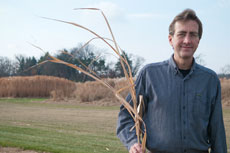Waterways contribute to increase in potent greenhouse gas
Nitrous oxide has increased by more than 20 percent over the past century, and nitrogen in waterways is fueling part of that growth, according to an MSU study.
 Nitrous oxide, a potent greenhouse gas, has increased by more than 20 percent over the past century, and nitrogen in waterways is fueling part of that growth, according to a Michigan State University study.
Nitrous oxide, a potent greenhouse gas, has increased by more than 20 percent over the past century, and nitrogen in waterways is fueling part of that growth, according to a Michigan State University study.
This new study indicates that the role of rivers and streams as a source of nitrous oxide to the atmosphere now appears to be three times higher than the estimate by the Intergovernmental Panel on Climate Change, according to ecosystem ecology and biogeochemistry researcher Stephen Hamilton, who works at the MSU Kellogg Biological Station – one of 14 Michigan agricultural experiment stations located across the state.
Hamilton was part of a team of researchers -- led by Jake Beaulieu of the Environmental Protection Agency -- that conducted experiments on 72 U.S. rivers and streams and ran their findings through a global river network model. They studied the production of nitrous oxide from denitrification, the process by which bacteria convert nitrates to nitrogen gases.
The increased production of nitrous oxide in streams can be traced to the growth in use of nitrogen fertilizers and the cultivation of crops that return nitrogen to the soil naturally, both of which have the unintended consequence of increasing nitrogen in streams. Some of the nitrogen entering streams is converted to nitrous oxide. Many studies have focused on how agricultural soils contribute to the production of this greenhouse gas, but the study points out that little attention has been given to nitrous oxide originating from streams and rivers.
Nitrous oxide exists at low levels in the atmosphere, but is thought to be responsible for 6 percent of climate warming. It also contributes to stratospheric ozone destruction. It packs a much bigger punch – on a molecular level – than carbon dioxide, Hamilton said.
"Nitrous oxide is the leading human-caused threat to the atmospheric ozone layer, which protects the earth from the sun's harmful ultraviolet radiation," said Hamilton, who works with the KBS Long-Term Ecological Research program. "And on a per molecule basis, its global warming potential is 300-fold greater than carbon dioxide's. Even with more than 99 percent of denitrified nitrogen in streams and rivers being converted to the inert gas nitrogen, river networks still contribute at least 10 percent of global anthropogenic nitrous oxide emissions."
Reducing use of agricultural fertilizer and other sources of nitrogen are examples of ways to decrease humanity's contribution to the growth of nitrous oxide produced in waterways, the study concluded.
The study appeared in the December issue of the Proceedings of the Academy of Sciences.
Hamilton's research and work with LTER are funded in part by the National Science Foundation and AgBioResearch.



 Print
Print Email
Email




